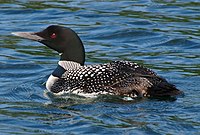
Photo from wikipedia
Simple Summary Animals frequently interrupt their activities to monitor their surroundings for possible threats such as predators and intruders. How animals carry out this vigilance has received little attention. In… Click to show full abstract
Simple Summary Animals frequently interrupt their activities to monitor their surroundings for possible threats such as predators and intruders. How animals carry out this vigilance has received little attention. In particular, the quality of vigilance depends on where animals look and how long each look lasts. We examine how vigilance is organized in the Florida scrub-jay (Aphelocoma caerulescens). During vigilance, these birds turn their heads in different directions to detect threats. We found that birds turned their heads regularly and also regularly returned their gaze to areas previously monitored, which is predicted when predators and intruders rely on surprise to approach. Birds turned their heads in several directions during vigilance, but often more frequently on one side of the body than the other, which was not predicted for regular vigilance. Looks were shorter in smaller groups and in juveniles presumably to increase visual coverage in more threatening situations. Visual monitoring strategies during vigilance reflect the risk posed by predators and intruders. Abstract Vigilance is important for early detection of threats. Previous studies have focused on the allocation of time to vigilance but neglected how animals monitor their surroundings during vigilance. Where animals look and how long each look lasts can affect the quality of visual monitoring and thus the ability to detect threats during vigilance. We examined visual monitoring strategies in the Florida scrub-jay (Aphelocoma coerulescens), a cooperative breeder with sentinel behaviour. Sentinels in this species make head turns from vantage points to detect the arrival of predators and intruding neighbours. We found that sentinels initiated head turns at regular intervals and also returned their gaze to areas previously monitored at regular intervals, which is predicted when predators and intruders rely on surprise rather than stealth to approach. Sentinels made head turns in several directions, but often more frequently on one side of the body than the other, which was not predicted for regular vigilance. Average look duration during sentinel bouts was shorter in smaller groups and in juveniles. We argue that shorter looks are beneficial to increase visual coverage in more threatening situations. Our study highlights how visual monitoring strategies during vigilance reflect the risk posed by predators and intruders.
Journal Title: Biology
Year Published: 2022
Link to full text (if available)
Share on Social Media: Sign Up to like & get
recommendations!